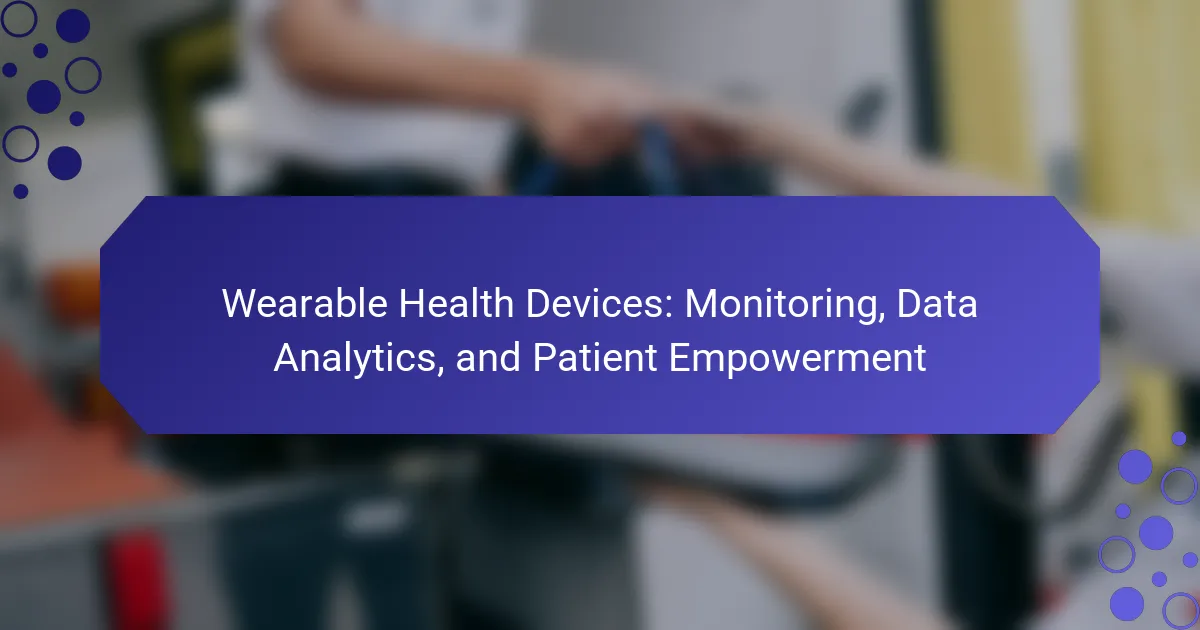Wearable health devices offer real-time health monitoring, empowering users to take control of their well-being. They track vital signs and activity levels, providing personalised health insights through advanced data analytics. These innovations enhance patient engagement and facilitate proactive health management, while also addressing challenges like usability and data privacy. The integration of AI-driven insights and telehealth services further improves communication between patients and healthcare providers.
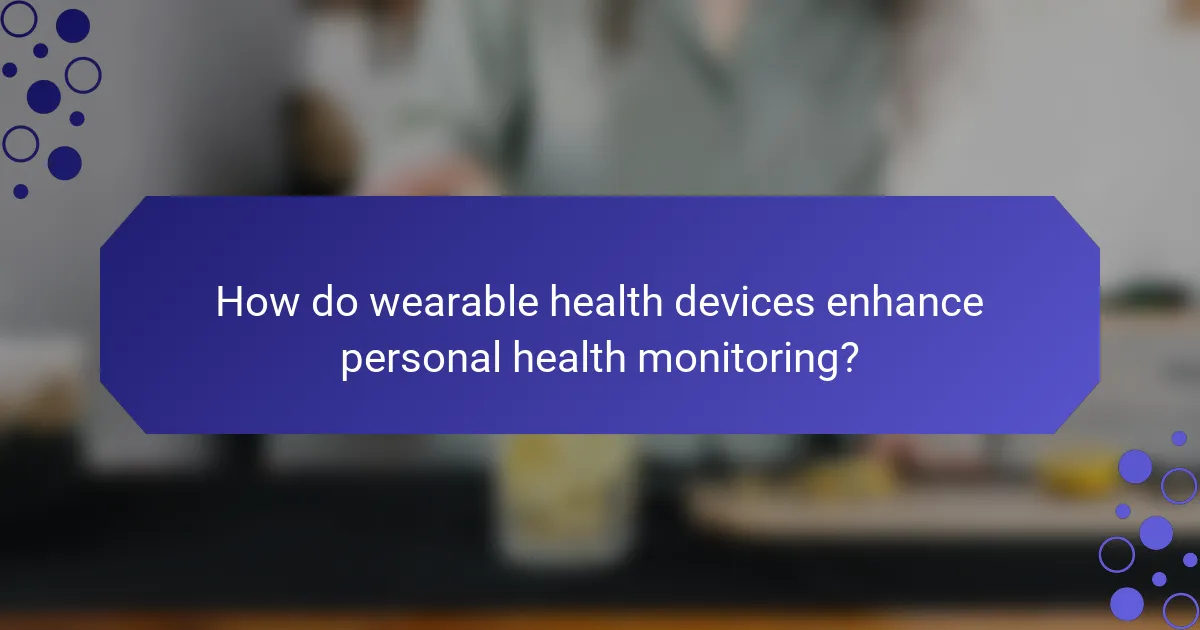
How do wearable health devices enhance personal health monitoring?
Wearable health devices significantly enhance personal health monitoring by providing real-time data, promoting user engagement, and facilitating proactive health management. These devices track vital signs, physical activity, and sleep patterns, offering insights that empower users to make informed health decisions.
The integration of advanced data analytics allows for personalised health recommendations, improving the overall effectiveness of health interventions. For instance, continuous heart rate monitoring can alert users to irregularities, leading to timely medical consultations.
Moreover, wearable devices foster patient empowerment by enabling users to take control of their health. Users can set goals, monitor progress, and share data with healthcare providers, enhancing communication and collaboration in managing health.
In summary, wearable health devices transform personal health monitoring through real-time data access, personalised insights, and increased patient involvement, ultimately leading to better health outcomes.
What types of health metrics can be tracked by wearable devices?
Wearable devices can track various health metrics, including heart rate, sleep patterns, physical activity, and stress levels. These metrics empower users to monitor their health effectively.
Heart rate monitoring provides real-time data on cardiovascular health. Sleep tracking analyses sleep quality and duration, aiding in better rest. Physical activity metrics, such as steps taken or calories burned, promote an active lifestyle. Stress level tracking can help users manage mental well-being.
These devices often integrate advanced analytics, offering personalised insights based on collected data. This capability enhances patient empowerment by encouraging proactive health management.
How do different demographics utilise wearable health technology?
Different demographics utilise wearable health technology in varied ways, reflecting their unique health needs and lifestyles. Older adults often focus on monitoring chronic conditions like heart disease, using devices that track vital signs and activity levels. In contrast, younger users typically engage with fitness trackers to enhance physical performance and maintain an active lifestyle.
Additionally, parents may use wearables to monitor their children’s health metrics, ensuring they stay active and healthy. Health-conscious individuals across demographics leverage data analytics to gain insights into their wellness, adjusting behaviours based on real-time feedback from devices.
The rise of telehealth has further empowered patients by integrating wearables with healthcare services, allowing for remote monitoring and timely interventions. This trend highlights the unique attribute of wearables in fostering patient empowerment through data-driven health management.
What are the key benefits of continuous health data collection?
Continuous health data collection through wearable devices enhances patient monitoring, improves data analytics, and empowers individuals. Key benefits include real-time health tracking, personalised insights, early detection of health issues, and increased patient engagement. These devices facilitate proactive health management by providing continuous feedback and fostering informed decision-making. Additionally, they contribute to better healthcare outcomes by enabling healthcare providers to tailor interventions based on accurate data.
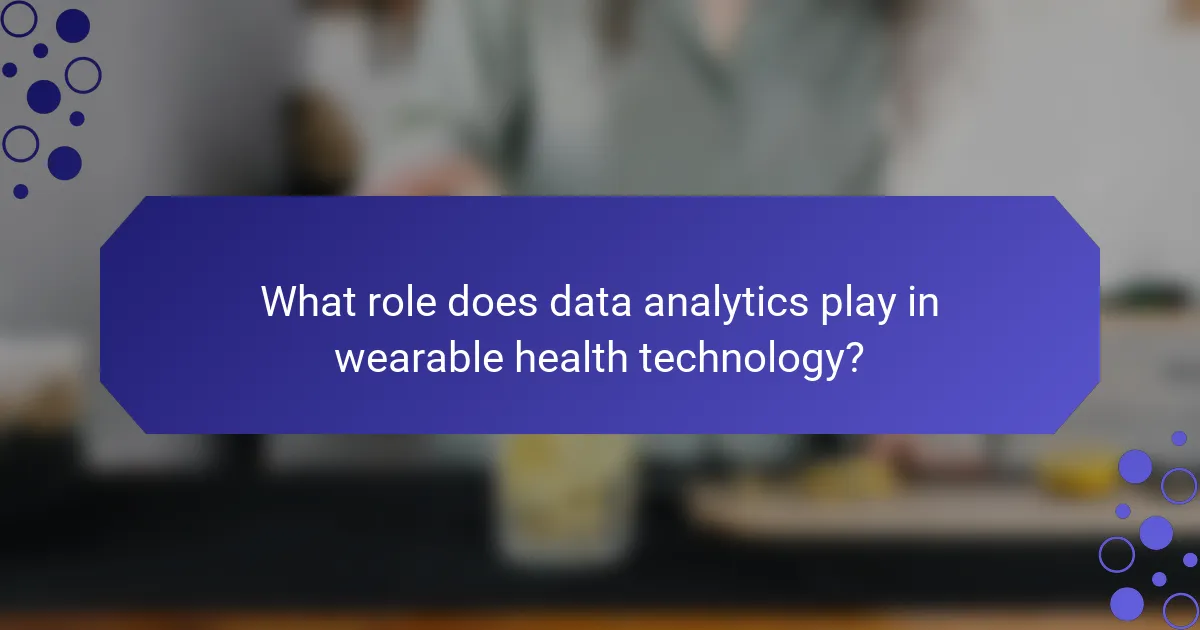
What role does data analytics play in wearable health technology?
Data analytics is crucial in wearable health technology as it transforms raw data into actionable insights. Wearable devices collect various health metrics, such as heart rate and activity levels. Advanced analytics processes this data, enabling personalised health management. For example, predictive analytics can forecast potential health issues, empowering users to make informed decisions. This capability enhances patient engagement and promotes proactive health behaviours, ultimately improving health outcomes.
How is data privacy managed in health wearables?
Data privacy in health wearables is managed through encryption, user consent, and data anonymisation. These devices collect sensitive health data, requiring robust security measures to protect user information. Encryption safeguards data transmission, while user consent ensures individuals control their data sharing. Anonymisation techniques further enhance privacy by removing identifiable information. Compliance with regulations, such as GDPR, also plays a crucial role in maintaining data privacy standards in wearable health technology.
What are the most common data analytics techniques used in health monitoring?
Wearable health devices utilise several common data analytics techniques for effective health monitoring. These techniques include descriptive analytics, which summarises historical data, predictive analytics that forecasts future health events, and prescriptive analytics that recommends actions based on data insights. Additionally, machine learning algorithms are frequently employed to identify patterns and anomalies in health data. These approaches empower patients by providing actionable insights and personalised health management strategies.
How do predictive analytics improve patient outcomes?
Predictive analytics enhance patient outcomes by enabling personalised care through real-time monitoring and data analysis. Wearable health devices collect vital health metrics, which predictive algorithms analyse to identify trends and potential health issues. This proactive approach empowers patients to make informed decisions about their health, leading to better management of chronic conditions and improved overall wellness. Moreover, timely interventions based on predictive insights can reduce hospitalisations and enhance the efficiency of healthcare delivery.
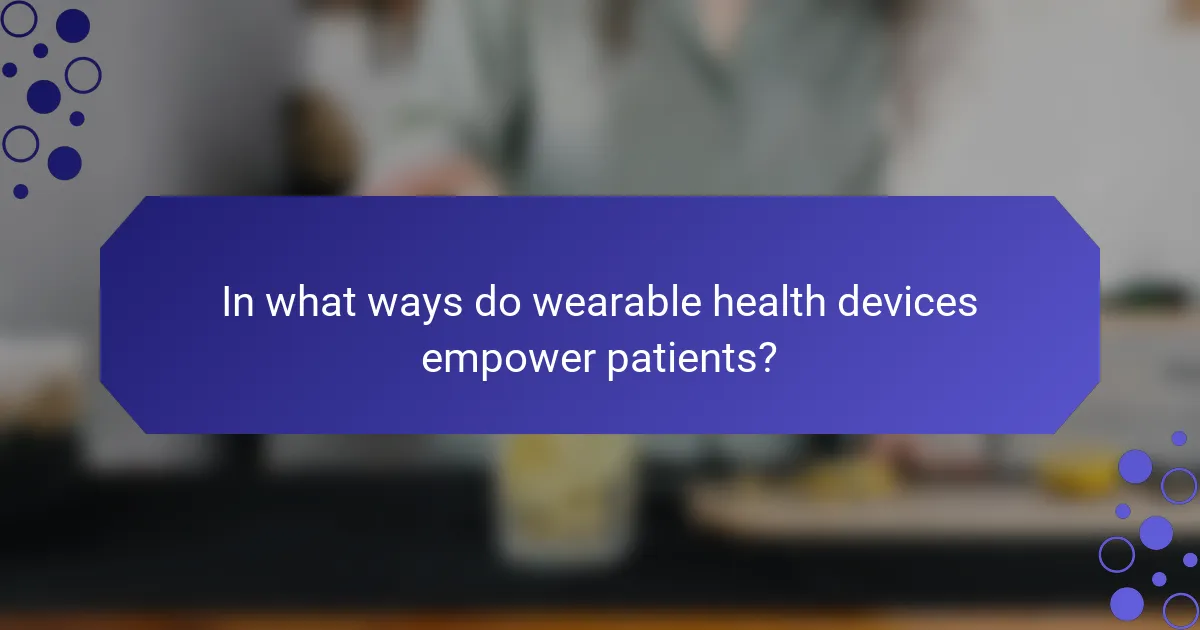
In what ways do wearable health devices empower patients?
Wearable health devices empower patients by providing real-time health monitoring and personalised data analytics. These devices enable users to track vital signs, manage chronic conditions, and engage in proactive health management. As a result, patients gain greater awareness and control over their health. Unique attributes, such as integration with mobile apps, enhance the user experience by offering tailored insights and recommendations. This data-driven approach fosters informed decision-making, ultimately leading to improved health outcomes.
How can wearables encourage proactive health management?
Wearable health devices promote proactive health management by providing continuous monitoring and real-time data analytics. Users can track vital signs, activity levels, and sleep patterns, empowering them to make informed decisions about their health. These devices enhance patient engagement, encouraging lifestyle changes and adherence to treatment plans. As a result, they facilitate early detection of potential health issues, improving overall health outcomes.
What features enhance user engagement with health data?
Wearable health devices enhance user engagement with health data through personalised feedback, real-time monitoring, and gamification features. These devices provide tailored insights, encouraging users to take proactive steps in their health management.
Additionally, data analytics capabilities allow users to track progress over time, fostering a sense of achievement. Integration with mobile applications further enhances accessibility, making health data more interactive and actionable.
The unique ability of these devices to connect with social platforms promotes community support, motivating users to share experiences and challenges. As a result, wearable health devices empower individuals to take charge of their health in a more informed and engaging manner.
How do wearables support chronic disease management?
Wearable health devices significantly enhance chronic disease management by enabling continuous monitoring, data analytics, and empowering patients. These devices provide real-time health metrics, allowing for timely interventions. For instance, smartwatches can track heart rates, while glucose monitors provide vital data for diabetes management.
Additionally, wearables facilitate data analytics by aggregating health information over time. This data can reveal patterns that inform treatment adjustments, improving patient outcomes. A study indicated that patients using wearables reported a 30% increase in adherence to treatment plans.
Patient empowerment is another critical aspect. Wearable devices encourage individuals to take an active role in their health management, fostering better lifestyle choices. This proactive engagement often leads to improved health literacy and self-efficacy.
In summary, wearable health devices support chronic disease management through continuous monitoring, insightful data analytics, and enhanced patient empowerment, ultimately leading to better health outcomes.
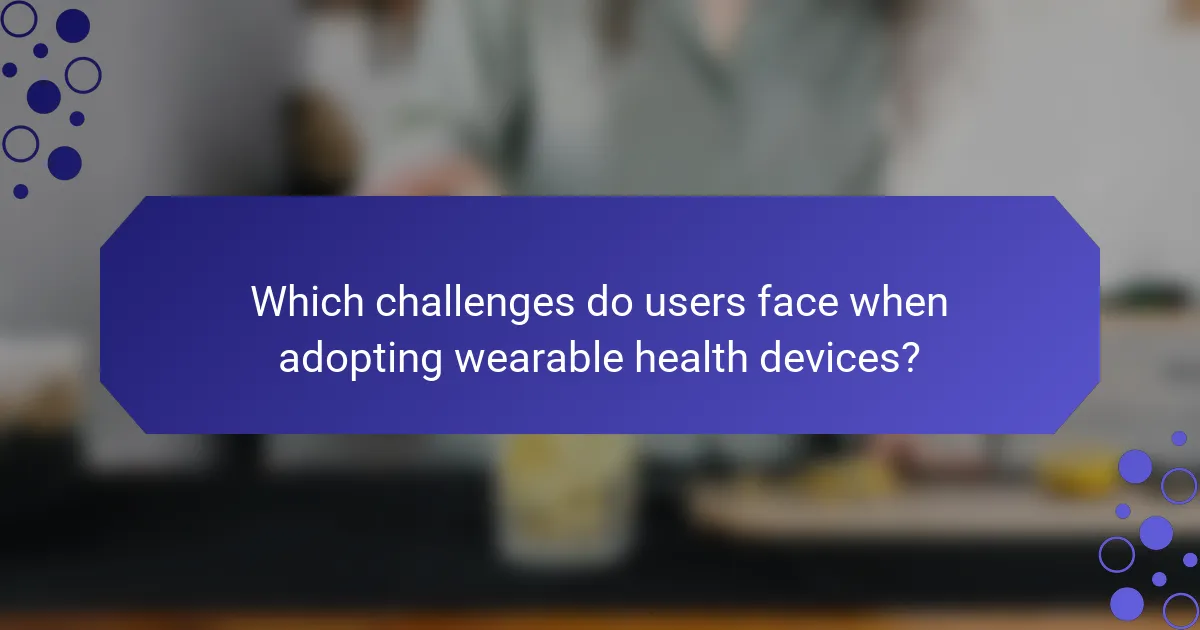
Which challenges do users face when adopting wearable health devices?
Users face several challenges when adopting wearable health devices, including usability issues, data privacy concerns, and integration with existing health systems. Many devices can be complex to set up and operate, leading to frustration. Data security is a significant worry, as users often question how their sensitive health information is handled. Additionally, the lack of standardisation among devices can hinder seamless integration with healthcare providers, complicating data sharing and analysis.
What factors influence user compliance with wearable technology?
User compliance with wearable technology is influenced by factors like usability, perceived health benefits, and social support. Devices that are easy to use and provide clear health insights encourage regular engagement. As a result, features such as intuitive interfaces and actionable data analytics enhance user experience. Additionally, social support from peers or healthcare providers can significantly boost motivation to adhere to usage. Studies show that users who share their data with others tend to use their devices more consistently.
How do technical issues affect user experience?
Technical issues can significantly hinder user experience with wearable health devices. Common problems include connectivity failures, inaccurate data readings, and software bugs. These issues can lead to frustration, reduced trust in the device, and ultimately decreased user engagement. For instance, a device that frequently disconnects from its app may discourage users from relying on it for health monitoring. Ensuring robust technology and regular updates can enhance reliability and improve overall satisfaction.
What misconceptions exist about wearable health devices?
Many misconceptions about wearable health devices include beliefs that they are always accurate, can replace medical advice, or are only for fitness enthusiasts. While these devices provide valuable data, they may not always capture complete health metrics. Users often think they require extensive technical knowledge, but many are designed for simplicity. Additionally, some believe that wearables guarantee improved health outcomes, though they primarily serve as tools for monitoring and awareness.
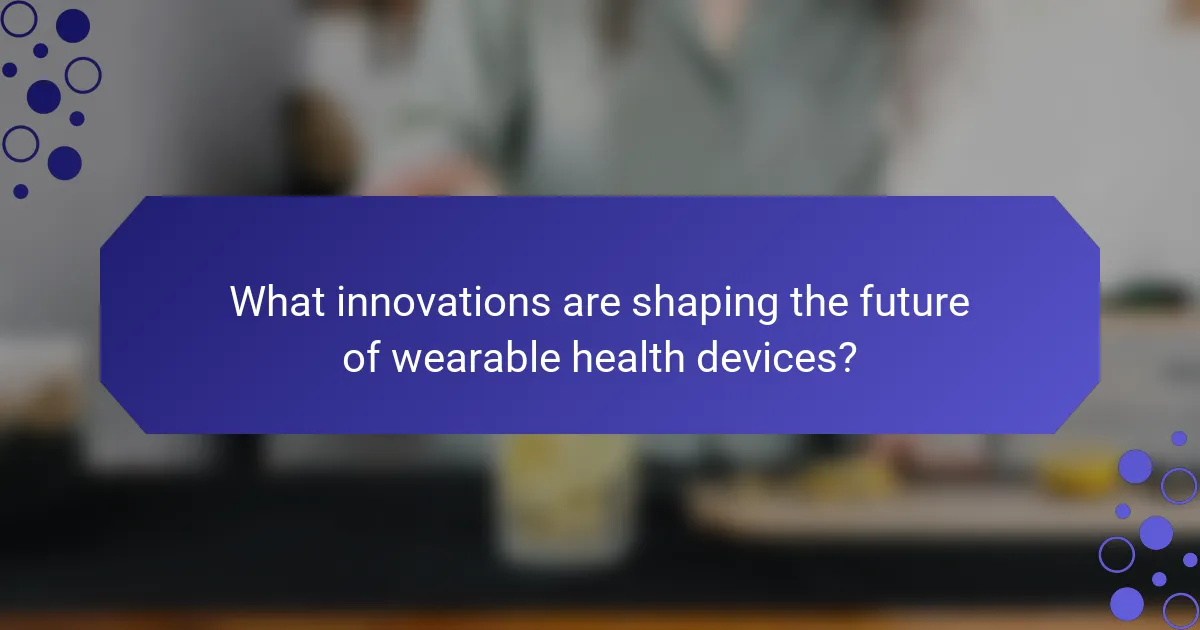
What innovations are shaping the future of wearable health devices?
Innovations in wearable health devices focus on advanced monitoring, data analytics, and enhancing patient empowerment. Key developments include real-time health tracking, AI-driven insights, and personalised health recommendations. These innovations improve user engagement and ensure timely medical interventions. For instance, devices now utilise machine learning algorithms to analyse biometric data, predicting potential health issues before they arise. Additionally, integration with telehealth services allows for seamless communication between patients and healthcare providers, fostering proactive health management.
How are advancements in technology improving device accuracy?
Advancements in technology are significantly enhancing the accuracy of wearable health devices. Innovations in sensor technology and data analytics have led to improved monitoring capabilities. For instance, devices now utilise advanced algorithms to analyse biometric data in real-time, allowing for precise health assessments. Enhanced connectivity features enable seamless data transfer, ensuring timely updates and more reliable health tracking. As a result, patients can make informed decisions based on accurate, up-to-date health information.
What emerging trends are influencing the wearable health market?
Emerging trends influencing the wearable health market include advanced data analytics, integration of artificial intelligence, and increased focus on patient empowerment. These trends enhance monitoring capabilities and provide personalised health insights.
The rise of AI-driven algorithms allows for real-time health monitoring, improving predictive analytics and early intervention strategies. This technology empowers patients by providing them with actionable data.
Additionally, the integration of wearables with telehealth services is expanding access to healthcare. This trend facilitates remote consultations and continuous patient engagement, fostering better health outcomes.
Lastly, the demand for interoperability among devices is growing. Users expect seamless data sharing across platforms, which enhances user experience and maximises the utility of wearable health devices.
How are integration capabilities evolving with other health systems?
Integration capabilities of wearable health devices are advancing rapidly with health systems. These devices now offer seamless data sharing, enhancing patient monitoring and analytics.
Interoperability between wearables and electronic health records (EHR) allows real-time data access. This integration empowers patients by providing insights into their health metrics. For example, heart rate variability data from wearables can inform clinical decisions.
Unique attributes, like remote patient monitoring, facilitate proactive healthcare interventions. As a result, healthcare providers can respond quickly to potential health issues.
The evolution of these integration capabilities signifies a shift towards patient-centred care, fostering greater engagement and improved health outcomes.
What can users do to maximise the benefits of wearable health devices?
To maximise the benefits of wearable health devices, users should actively engage with the data provided. Regularly monitor health metrics, set personalised goals, and utilise data analytics features to inform lifestyle choices.
1. Sync devices with health apps for comprehensive insights.
2. Review trends over time to identify patterns and adjust behaviours.
3. Share data with healthcare providers for tailored advice.
4. Participate in community challenges to enhance motivation.
These actions empower users to take control of their health journey effectively.
